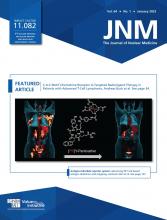REPLY: Thank you for the opportunity to respond and provide further insight into this complex and rapidly evolving field.
A multitude of experts took no issue with use of the word selection for the screening criteria for prostate-specific membrane antigen (PSMA) PET in the VISION trial (1), but I appreciate concerns about the word choice and hope to clarify. Patient selection is a commonly used term in typical parlance and written protocols for clinical trials. It was not intended that using selection versus some other term would necessitate obtaining some special burden of clinical data or meet some sort of claim, like a legal term. If not selection, then what term should we use? My colleagues and I have also used the term eligibility or screening criteria in discussions and presentations if that would be less controversial or preferable.
I do not understand how the term selection would be interpreted to mean that “PET agents alone are useful in predicting which patients are and are not likely to respond to [radioligand therapy (RLT)].” Clearly, PET alone is not the only important factor to consider. The VISION trial had nonimaging exclusion criteria. Indeed, Gafita et al. published a retrospective analysis demonstrating that many nonimaging factors are important to outcomes (2).
The author criticizes that the Food and Drug Administration (FDA) label is based on the VISION trial. FDA labels should be based on data and thus strongly influenced by the phase 3 trials used for the drug approval. Conversely, the FDA could have been criticized for not including PSMA PET on the label, as it was criticized for not including amyloid PET initially on the label for aducanumab. In my opinion, using an alternative to the word selection would not have changed the FDA’s decision, which was based on the trial methodology regardless of the semantics. The practice of medicine need not strictly follow the FDA label, and the longer after a drug has been approved and the more trials that have since been performed, the greater is the likelihood that it routinely does not.
Regarding the point that the “usefulness of the criteria was not piloted in clinical trials before their use in VISION,” a phase 3 trial does not need to replicate the methodology of the preceding phase 2 trial. Indeed, one should apply lessons from the phase 2 trial to optimize phase 3. In this case, we used results from phase 2 trials published in the scientific literature to develop this protocol, which (to our knowledge) was the first phase 3 registrational trial for a PSMA-targeted theranostic.
At the request of the FDA, a VISION substudy was designed and conducted to test whether baseline PSMA PET could be a prognostic tool for clinical outcomes from 177Lu-PSMA-617. A higher whole-body SUVmean was strongly associated with improved outcomes (overall survival and radiographic progression-free survival) from 177Lu-PSMA-617. Even the patients in the lowest quartile of the whole-body SUVmean showed greater survival than the arm receiving the standard of care alone (3). Analysis of the baseline PSMA PET scans from the standard-of-care–alone arm is under way. Ultimately, I hope that analyses such as these will allow for more personalized use of RLT, particularly as more therapeutic options are approved. Earlier this year, an important retrospective study by Hotta et al. classified patients treated with 177Lu-PSMA using the PSMA PET VISION criteria and found a survival difference between the groups (4).
We need more research into the group of patients excluded by the VISION PSMA PET selection or eligibility criteria. Although the VISION trial was not designed to answer many important questions that remain, it has provided us the breakthrough approval of a PSMA-targeted RLT. In my view, criteria are not meant to be static. The VISION selection criteria were not intended to be the only and everlasting criteria for PSMA-targeted trials. If the intention is to maximize benefit, then the criteria should be more restrictive; on the other hand, one needs to loosen the criteria to benefit a greater proportion of the patient population. Criteria need to be adjusted to different patient populations and different pharmaceuticals (5). The VISION trial has given us this first phase 3 level of data, and as more large trials give us high-level evidence, the criteria should continue to evolve to serve patients better.
DISCLOSURE
Phillip Kuo is an employee of Invicro. He is a consultant or speaker for Amgen, Eisai, Endocyte, GE Healthcare, Novartis, Invicro, Bayer, Chimerix, Fusion Pharma, and UroToday. He is a recipient of research grants from Blue Earth Diagnostics and GE Healthcare. No other potential conflict of interest relevant to this article was reported.
Footnotes
Published online Oct. 13, 2022.
- © 2023 by the Society of Nuclear Medicine and Molecular Imaging.







